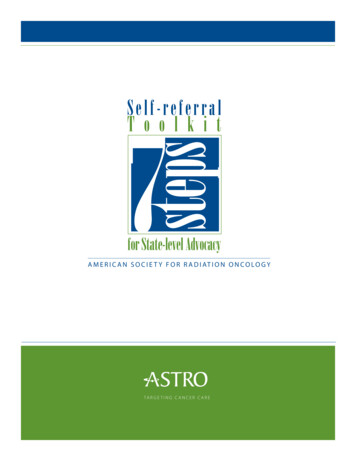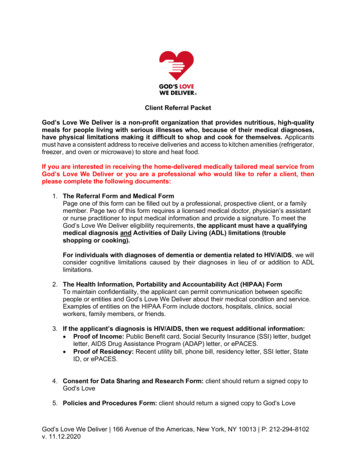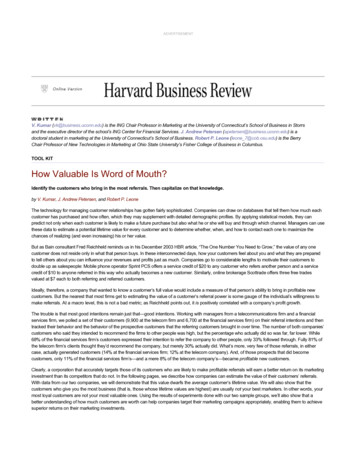
Transcription
Self-referralT o o l k i tsteps7for State-level AdvocacyA M E R I C A N S O C I E T Y F O R R A D I AT I O N O N C O L O G YTA R G E T I N G C A N C E R C A R E
PrefaceASTRO RoleSelf-referralT o o l k i tsteps7for State-level AdvocacyA M E R I C A N S O C I E T Y F O R R A D I AT I O N O N C O L O G Y
ASTRO’s Role in State AdvocacyThe American Society for Radiation Oncology now boasts a mature government relations departmentthat has demonstrated an ability to promote radiation oncology in Washington, DC, and defend thespecialty from threats to its future. ASTRO’s government relations activities consist of legislative andregulatory advocacy on issues facing the specialty in Congress and the federal government, includingdirect lobbying, organizing and mobilizing grassroots support for legislation and issues, political givingthrough ASTRO’s Political Action Committee, comment letters to federal agencies or proposedregulations, building strategic alliances with patient and provider groups, and numerous other efforts.At the direction of ASTRO’s leadership, ASTRO’s government relations activities are focused on policyat the federal level. ASTRO maintains a qualified staff of registered federal lobbyists with experienceand relationships geared toward advancing ASTRO’s policy agenda in Washington, DC.ASTRO’s government relations staff does not include individuals with experience or relationships toadvance policy issues at the state level. With limited resources available, ASTRO’s leadership hascontinued to stress that government relations activities remain focused at the federal level, whilesupporting and coordinating with individual ASTRO members interested in moving policy at the statelevel.It is in this context that ASTRO created its Grassroots State Captain network in 2008, with a dualpurpose of leading efforts in each state to influence health care policy at the federal and state level.To support the work of the State Captains and others who wish to lead efforts to combat abusive selfreferral at the state level, ASTRO’s Government Relations Committee and staff have created this StateSelf-Referral Toolkit. It is our hope that this toolkit will provide ASTRO members significant guidanceand support in their efforts to change self-referral laws in their states. In addition, we urge advocatesto ensure that they keep ASTRO staff and leaders well informed of their efforts and progress, as wellas coordinating with ASTRO staff to ensure that gains at the state level can support change at thefederal level.
Step 1Introduction to Self-ReferralSelf-referralT o o l k i tsteps7for State-level AdvocacyA M E R I C A N S O C I E T Y F O R R A D I AT I O N O N C O L O G Y
Self-Referral: The BasicsBackground—Self-Referral in Radiation OncologyPhysician self-referral is the practice of a physician ordering a service on a patient that is performedeither by themselves or by a facility from which they derive a financial benefit for the referral. Moststates have some restrictions on the practice of physician self-referral. However, each state is variedwhen it comes to which physician services are regulated by self-referral laws and to what degree theyare restricted.For patients with localized prostate cancer, external beam radiation therapy, radioactive seeds(brachytherapy), prostate surgery and active surveillance are all considered “clinically equivalent”treatments, according to a 2008 Agency for Healthcare Research and Quality comparativeeffectiveness review. The report noted that because the treatments have varying side effects, patientpreferences are an important factor in determining a management strategy. The NationalComprehensive Cancer Network clinical guideline states that a patient with clinically localizedprostate cancer should be informed about the commonly accepted interventions, and a discussion ofthe anticipated benefits and risks of each intervention should occur with the patient.Determining the most appropriate prostate cancer treatment option is an involved process thatdepends on the patient’s preferences, age, concerns, co-morbidities and physiology. We believe thatwhen referring urologists own radiation therapy facilities, they are so heavily incentivized to refertheir patients for external beam radiation therapy services that their clinical decision-makingbecomes biased and likely leads to overutilization of radiation therapy. Specifically, these modelschannel referrals to a particular radiation therapy, called intensity modulated radiation therapy(IMRT). IMRT is particularly of interest because of the technical fees that are billed by the owner ofthe linear accelerator. In January 2009, the Institute for Clinical and Economic Review produced areport comparing the clinical benefit and costs of the various treatments for low-risk prostate cancer.The report concluded that the rates of survival and tumor recurrence are similar among the mostcommon treatment approaches, although costs can vary considerably, with surgery andbrachytherapy costing significantly less than IMRT.Physicians, especially those who are in a position to refer patients for radiation therapy services, haverealized that if the provision of these services and the related billing of the technical fees for theequipment can be “captured,” financial gain can be achieved based upon the referral decisions. Thisbusiness dynamic has been identified, packaged and is being marketed to physician groups,particularly within the urology community, by for-profit companies that specialize in fueling theenthusiasm about lucrative joint ventures with financially aggressive physicians.Consequences of Self-ReferralSelf-referral business models run counter to crucial health care policy goals, including patient choice,quality of care and access to services. By setting up a business model that holds radiation oncology
services captive to the referring physician, and by driving patient referrals only in that direction,cancer patients are denied the independent clinical judgment and choice they need and deserve.Under these arrangements, the quality of cancer care suffers. The physician practice will steerpatients toward the services they wish to offer, rather than those that might be better for thepatient. Perhaps of even greater concern is the fact that for some prostate cancer patients, it maysimply be that “watchful waiting” is the most prudent course of treatment, while for others, surgerymight be the best approach. However, with the financial return that a urology group can realize onIMRT treatments, there is considerable risk that “watchful waiting” or surgery will not be thoroughlypresented to the patient as a viable treatment options. In addition, there is a population of patientswho generally should not be treated at all, such as the elderly or those with serious co-morbidities.On December 8, 2010, The Wall Street Journal investigated several urology group practices, includingone of the largest, Integrated Medical Professionals (IMP), that have used the self-referral exceptionto bring external beam radiation therapy services into their offices. The article revealed two majorfindings: Urology groups that brought IMRT into their practices had utilization rates well above nationalnorms for use of that treatment for prostate cancer. Moreover, the practice patterns for thesegroups showed dramatic utilization increases following equipment purchase.These practices treated a higher than average number of men over the age of 80 withradiation therapy for their low-risk prostate cancer. Experts agree that in most instances, 80 year-old men with low-risk prostate cancer do not need aggressive treatment.On February 15, 2011, The Washington Post also published a story exposing self-referral abuses inradiation oncology. The article quotes world-renowned Johns Hopkins urologist Patrick Walsh, MD,criticizing the “for-profit motive” affecting treatment decisions for some physicians involved in selfreferral arrangements.A Baltimore Sun article in January 2012 described how a Maryland urology clinic’s prostate cancerreferrals for IMRT tripled after they purchased a radiation therapy machine. As the article states, “Themore patients the Baltimore-area urologists referred for that expensive therapy alternative, the morerevenue and profits they would generate.” The Maryland data is part of a national study by Georgetown University coming out in mid2012. It is expected to show that urology practices across the country drastically increasedexpensive IMRT referrals after they acquired a radiation therapy machine.A published survey of radiation oncology residency program directors across the country revealedthat 27 percent of residency programs in communities with these business arrangements reported anegative impact on residency training as a result of decreased referrals to their centers. While this is asmall survey sample, it foreshadows large quality problems in the future if residents do not see theappropriate case mix of patients necessary to develop the skills they need to treat prostate cancerpatients.
In 2012, independent reports from the Government Accountability Office and the CongressionalBudget Office are expected to be released showing the clinical and economic impact to the Medicareprogram of physician self-referral on the provision of radiation oncology services.Those benefitting financially from their ability to control radiation therapy services and the resultantrevenues within their business unit assert that they are delivering “integrated care” or providingaccess in underserved areas. The notion that these are the driving forces in the creation of thesefinancially lucrative business models is contradicted by the marketing materials published by at leastone national for-profit purveyor of this approach, URORAD, based in McAllen, Texas, which highlightthe potential for huge revenues by incorporating IMRT into a urology practice.Politics at PlayPolitically, groups supporting laws that limit the restrictions on self-referral are outspoken, willing todefend their business arrangements to their elected officials, and understand the concept of strengthin numbers. Urology groups have been strategic in their approach to political giving, donatinghundreds of thousands of dollars to their federal lawmakers. This is likely occurring with the sameforce at the state level.Restricting physician self-referral at both the state and federal level is an uphill battle that will take asignificant investment of resources, require a strong will, and likely will take years to achieve success.In some states, it may even be an impossible task. There are many factors at play that affect thisissue. Before attempting to advance state legislation to restrict self-referral in radiation oncology, itwould be wise to undertake a careful environmental scan of the various stakeholders, politicalrelationships and existing state regulations.
State and Federal Intersection of Self-ReferralI.Federal Stark LawOverview of Stark LawThe federal self-referral law, otherwise known as the Stark Law, prohibits a physicianfrom referring Medicare patients for certain “designated health services” to an entity withwhich the physician or the physician’s immediate family member has a financial relationship(ownership, investment or compensation), unless one of the Stark Law’s many enumeratedexceptions applies. Not only does the Stark Law prohibit such referrals, it also prohibits theentity receiving such a referral from presenting or causing to be presented a claim toMedicare for the designated health service that was provided pursuant to the prohibitedreferral. Violations of the Stark Law can result in severe penalties, e.g., denial or refund ofMedicare payments for services provided pursuant to the prohibited referrals, civil monetarypenalties, exclusion from federal health care programs and potential False Claims Act liability.Applicability Outside of MedicareThe Stark Law statute, regulations, government sub-regulatory pronouncements andenforcement of the law all make clear that the Stark Law currently applies only to referrals ofMedicare patients and claims for Medicare payments. While the language of the Stark Lawmentions Medicaid, the Centers for Medicare and Medicaid Services has made clear in itsrulemakings that the Stark Law is not applicable to Medicaid at this time.II.State Laws Prohibiting Self-ReferralsScope of State Self-Referral LawsIn part because the Stark Law only applies to Medicare referrals and payments, thevast majority of states have enacted laws similar to the Stark Law. Like the Stark Law, theselaws are fundamentally designed to prohibit or limit the ability of a physician from referringcertain patients to certain entities if the physician has a financial relationship with the entity.While a few states, like Michigan, merely incorporate the federal Stark Law and itsimplementing regulations by reference and apply it to all payers of health care services (suchas Michigan’s health care programs), other states’ self-referral laws deviate in scope,substance and interpretation – not only from the federal Stark Law, but also from each other.For example, state laws may differ with respect to the type of entities to which referrals areprohibited (e.g., hospitals only versus all health care providers), the type of conduct that isprohibited (e.g., all ‘self-referrals’ versus only ‘self-referrals’ if the physician’s financialrelationship with the entity has not been disclosed to the patient), the type of servicescovered (e.g., a defined set of designated health services versus any service) or the type ofclaims that are prohibited (e.g., claims to Medicaid, workers compensation, and/or anycommercial payor or self-pay patient, etc.).
Example of the Differences Between State Self-Referral LawsA comparison of Connecticut’s and Ohio’s self-referral laws demonstrates this variance. Connecticut’s selfreferral law applies to “each practitioner of the healing arts” (not just physicians), covers the referral of anydiagnostic or therapeutic service, and does not prohibit all ‘self-referrals’ but instead requires disclosure of thepractitioner’s financial interest to the patient prior to the referral, along with a reasonable referral alternative.Ohio’s self-referral law, on the other hand, applies solely to physicians, covers referrals of only certain“designated health services,” including clinical laboratory services, home health care services and outpatientprescription drugs, and prohibits all ‘self-referrals’ unless an exception applies – regardless of whether thereferring physician’s financial relationship is disclosed to the patient. Moreover, the limitations and exceptionsto the states’ self-referral laws vary as well. Some states’ laws provide no exceptions while other states’ lawsprovide few or numerous exceptions – and they often vary in scope and substance. For these reasons, allpractitioners would be wise to understand the significance of not only the federal Stark Law, but also the selfreferral laws of the state(s) in which they practice.EnforcementVarious state regulatory bodies have the authority to enforce the states’ self-referral laws. These stateregulatory bodies include states’ Boards of Medicine or Boards of Physicians (licensing and discipline), and/orstate Attorneys General (civil and other penalties). Although various regulatory bodies have the authority toenforce the states’ self-referral laws, many states have little or no history of enforcing their state’s law.Among the states that have enforced these laws, some have done so by prosecuting physicians and/or entitieswho violate the law, while others (through either the state’s Attorney General or Board of Physicians) haveissued advisory opinions in response to requests for guidance regarding the scope of the state’s self-referrallaw. Examples include South Carolina’s Attorney General opining on whether the scope of South Carolina’sself-referral law includes chiropractors, the Attorney General of California addressing whether a physician mayprescribe for a patient a medical device that is distributed by a company in which the physician has anownership interest, and the Attorney General of Virginia’s opinion on whether a health practitioner who hasan ownership interest in an entity that operates a licensed hospital may refer patients to that hospital forhealth services.The Issue of PreemptionIn general, the federal Stark Law is not considered to have a preemptive effect on the states’ self-referralslaws, in part because the federal Stark Law applies to conduct affecting the Medicare program and the states’self-referral laws typically apply to state and other programs. In other words, the federal Stark Law and thestates’ self-referral laws often complement each other, rather than conflict with each other. Nonetheless, theFlorida Supreme Court in 2006 raised the possibility that the federal Stark Law might, in certain circumstances,preempt a conflicting state self-referral law. In State of Florida v. Harden, 938 So.2d 480 (Fla. 2006), the FloridaSupreme Court ruled that the federal health care program anti-kickback statute preempts Florida’s antikickback statute. The Court examined material differences between the two laws, including the lack of a safeharbor in the Florida law that is included in the federal anti-kickback law. According to the Court, this
difference could result in Florida law criminalizing conduct that federal law specifically intends to be immunefrom scrutiny. Based on such material differences, the Court concluded that the federal health care programanti-kickback statute preempts the Florida anti-kickback law because the latter stood as an obstacle to theaccomplishment of Congress’ purposes and objectives. Thus, to the extent the federal Stark Law materiallyconflicts with a state’s self-referral law, the former may be found to preempt the latter. However, no rulingmade by any authority has yet to conclude that the federal Stark Law actually preempts any state’s self-referrallaw.III.State Self-Referral Laws as ‘Laboratories’ for Policy InitiativesGiven the various constituencies to which state congressional and general assemblies mustattend, some states’ self-referral laws are deliberately designed (and amended) to address real orperceived economic and market infirmities particular to their region. For instance, the MarylandGeneral Assembly enacted Maryland’s ‘self-referral’ law to substantially restrict the ability of nonradiologist physicians to ‘self-refer’ their patients for MRI scans, CT scans and radiation therapyservices. In recent years, some non-radiologist physicians questioned the scope of the law, claimingthat exceptions to the law allowed them to ‘self-refer’ their patients for MRI services, CT scans andradiation therapy services provided on equipment in which the physician has a financial interest. TheMaryland Attorney General and the State Board of Physicians opined on the issue and both concludedthat non-radiologist physicians could not refer their patients for these services. Dissatisfied, severalnon-radiologist physicians sought (but did not obtain) relief from the judicial branch. In Potomac ValleyOrthopedic Associates v. Maryland State Board of Physicians, 12 A.3d 84 (Md. 2011) (a case in whichASTRO filed an amicus brief in support of the Maryland State Board of Physicians), Maryland’s highestcourt considered the State Board of Physicians’ interpretation of the law, several opinions ofMaryland’s attorney general and evidence of legislative intent before affirming the lower court’s rulingthat, in Maryland, the state self-referral law prohibits non-radiologist physicians from self-referring apatient for an MRI, CT scan or radiation therapy service, even if the service would be performed byanother member of the physician’s practice group. In other words, legislative and other efforts inMaryland have created a situation in which state law prohibits a urologist from ‘self-referring’ apatient for radiation therapy services, even if another physician in the urologist’s group practice wouldperform such services.IV.ConclusionPhysicians and the financial arrangements in which they participate are underincreasing scrutiny not only by government agencies who enforce self-referral laws but alsoby other health care practitioners who are concerned that permitting practitioners who lackthe particular expertise to perform certain services could lead to inappropriate patientselection, technically inadequate treatment delivery and poor patient outcomes. Due to thisscrutiny, to the varying scope of the federal Stark Law and the states’ self-referral laws, andthe evolving interpretations of those laws, it is critical to understand and be able to navigateall applicable self-referral laws in order to comply with such laws, avoid penalties flowingfrom such laws, or urge legislative or government enforcement activity concerning such laws.
ASTRO’s Progress on Self-ReferralASTRO has been working vigorously to close the in-office ancillary services exception for radiationtherapy services. ASTRO is very concerned that abuse of this exception has led to some cancerpatient’s treatments being driven by considerations of profit rather than sound clinicaljudgment. Here is a timeline of milestones:2008 March: ASTRO brought 100 physicians to Washington, DC, for its annual “Advocacy Day”event. ASTRO members were urged to tell Congress about radiation oncology and that is notan ancillary service. March: ASTRO leaders followed up on official comments to CMS urging the removal ofradiation therapy from the Stark exception by meeting with CMS officials. April: ASTRO filed second comment letter expanding comments on this issue. August: The HHS Office of Inspector General issued Advisory Opinion 08-10 on a jointurology/radiation oncology venture to offer IMRT services. The OIG concluded that theproposed arrangement could potentially generate prohibited remuneration under the antikickback statute.2009 January: ASTRO sent a letter to the AMA Board of Trustees in support of House of DelegatesResolution 842, which affirmed that radiation therapy is not ancillary to any service andaffirmed that AMA would oppose any legal or other designation of radiation therapy asancillary. February: ASTRO requested that the Office of Inspector General (OIG) issue a Special FraudAlert highlighting the legal and health care policy concerns that may arise when physiciangroups reorganize to capture certain radiation therapy service referrals. February: ASTRO sent the first of three letters to the Obama Administration urging the end ofabuses of the physician self-referral law by removing radiation therapy services from the inoffice ancillary services exception to the Stark Law. April: ASTRO staff met with numerous members of Congress and staff on self-referral inradiation therapy, following up on Advocacy Day meetings and initiating high-level meetingswith staff on key committees. Hill staff said data is needed on the extent of abuse of selfreferral in radiation therapy. Until such data is provided, Hill staff have been reluctant to closethe ancillary services loophole. May: ASTRO’s President Tim Williams, MD and ASTRO staff met with Medicare PaymentAdvisory Commission (MedPAC) staff and requested MedPAC analyze self-referral in radiationtherapy. June: ASTRO’s Louisiana state captain initiated an effort that resulted in both state legislativebodies passing self-referral resolutions that were signed by the Secretary of State.
August: A new urology coalition formed to “oppose” ASTRO’s efforts to remove radiationtherapy from the IOAE. September: ASTRO staff worked with the Tennessee state captain and local organizationsagainst a certificate of need application filed by several urology groups to open a prostatecancer treatment center that included radiation therapy services. The group helped convincea Tennessee state agency to deny the urologists’ application. ASTRO staff also briefed the stafffor the two federal Senators from Tennessee on the decision and elicited their support forfuture self referral efforts. October: Following up on ASTRO’s May meeting, MedPAC considered whether to do furtherresearch and possibly recommend changes to the Stark law exception. MedPAC’s chairmanand others noted concerns about how ownership might skew treatment decisions in radiationtherapy. During the public comment session and in written comments, ASTRO staff expressedconcerns about self-referral in radiation therapy. October: ASTRO staff met with the new CMS officials reviewing self-referral issues andprovided them with information on ASTRO’s desire to remove radiation therapy from theStark exception. October: ASTRO secured language in House health reform bill to study self-referral inradiation oncology.2010 January: ASTRO secured self-referral study language in reconciled House-Senate reform bill;however, Massachusetts Senate election forced Congress to pursue legislative vehicle thatcould not include study language. February: ASTRO’s board approved a proposal to contract with Jean Mitchell, PhD, ofGeorgetown University to study the impact of self-referral on radiation oncology practicepatterns and patient choice. ASTRO physicians testified before two House committeesexamining cancer treatment issues discussed concerns about the impact of physician selfreferral in radiation therapy. April: Reps. Waxman, Stark and Levin requested that the Government Accountability Officeconduct a study to review self-referral and radiation therapy services. May: In New Jersey, the state’s Senate health committee unanimously approved legislation tocreate a two year ban on new, non-radiation oncology owned freestanding centers. June: MedPAC’s June report included a discussion about self-referral and possible changes tothe in-office ancillary services exception. August: ASTRO joined forces with groups representing radiology, pathology, and physicaltherapy, by creating an informal coalition, called the Alliance for Integrity in Medicare (AIM),to jointly work to close the self-referral loophole for these services. The groups met jointlywith numerous members of Congress and sent letters on the issue to the ObamaAdministration. September: ASTRO leadership met with GAO analysts conducting the self-referral in radiationoncology to express ASTRO’s serious concerns about abuses.
October: ASTRO sent MedPAC a letter reiterating its concerns about self-referral. Inconjunction with coalition partners, ASTRO sent a letter to the Obama Administrationrequesting that they close the loophole. December: After six months of numerous interviews and information sharing between ASTROstaff and leaders with The Wall Street Journal, the newspaper published its extensiveinvestigation into self-referral in radiation oncology. The article presented first-of-its-kind datashowing overutilization among urology-owned radiation oncology centers.2011 January: The Maryland state appeals court affirmed a lower court’s ruling against a challengeby physician groups to the state’s self referral law, which protects against self-referral forradiation therapy as well as MRI and CT scans. ASTRO worked to ensure the state legislaturedid not repeal the ban. February: After speaking with ASTRO staff and leaders, The Washington Post published a storyexposing self-referral abuses in radiation oncology. The article quotes Johns Hopkins urologist,Patrick Walsh, MD, criticizing the “for-profit motive” that is affecting treatment decisions inself-referral arrangements. March: Key Members of Congress and staff tell Advocacy Day attendees about interest inreviewing data on self-referral in radiation oncology and potentially making policy changes toaddress problems. September: ASTRO and colleagues in the AIM self-referral coalition secured a Senator toofficially request the Congressional Budget Office to develop a cost-estimate of legislation toclose the self-referral loophole. ASTRO and its coalition partners sent a letter to the JointDeficit Reduction committee urging them to close the self-referral loophole. October: ASTRO developed self-referral state toolkit to help ASTRO members advancelegislation at the state-level. Interim data from the ASTRO-sponsored self-referral study waspresented at ASTRO Annual Meeting.
State Self-Referral LawsStateDirectly Related to RadiationTherapyArizonaIndirectly Related to Radiation TherapyProfessions and Occupations- Board ofChiropractic Examiners- A.A.C. R4-7-902Unprofessional or Dishonorable Conduct Activitieshttp://www.azsos.gov/public services/Title 04/407.pdfProfessionals and Occupations- Medicine andSurgery- A.R.S. § 32-1401- ?inDoc /ars/32/01401.htm&Title 32&DocType ARSProfessionals and Occupations- NaturopathicMedicine- A.R.S. § 32-1501- ?inDoc /ars/32/01501.htm&Title 32&DocType ARSProfessions and Occupations- Board ofOptometry- A.A.C. R4-21-303- Affirmativedisclosures in advertising and practice; warranties,service, or ophthalmic goods replacementagreements.http://www.azsos.gov/public services/Title 04/421.htmProfessionals and Occupations- OsteopathicPhysicians and Surgeons- A.R.S. § 32-1854Definitions of unprofessional Doc /ars/32/01854.htm&Title 32&DocType ARSProfessionals and Occupations- Board of PhysicalTherapy- A.R.S. § 32-2044- Grounds fordisciplinary oc /ars/32/02044.htm&Title 32&DocType ARSProfessionals and Occupations- Physician
Assistants- A.R.S. § 32-2501- ?inDoc /ars/32/02501.htm&Title 32&DocType ARSArkansasHome Intravenous Drug Therapy Services Ark. Code Ann. § 20-77-804http://web.lexisnexis.com/research/
7 steps for State-level Advocacy Self-referral Toolkit AMERICAN SOCIETY FOR RADIATION ONCOLOGY TARGETING CANCER CARE. Preface ASTRO Role 7 steps for State-level Advocacy . purpose of leading efforts in each st










